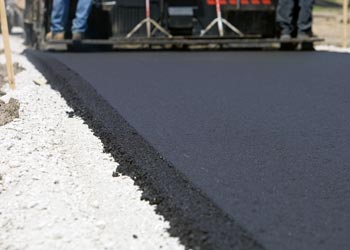The Only Guide to A1 Professional Asphalt & Sealing Llc
The Only Guide to A1 Professional Asphalt & Sealing Llc
Blog Article
A1 Professional Asphalt & Sealing Llc - Truths
Table of ContentsUnknown Facts About A1 Professional Asphalt & Sealing LlcA1 Professional Asphalt & Sealing Llc Things To Know Before You BuyThe 10-Second Trick For A1 Professional Asphalt & Sealing LlcA1 Professional Asphalt & Sealing Llc Things To Know Before You Buy6 Easy Facts About A1 Professional Asphalt & Sealing Llc Shown

The oil in a car engine is not simply oil. The REOB has all the additives that were in the waste oil as well as the wear metals from the engine (mainly iron and copper).
By making many blends making use of various REOB examples and different asphalt binders, the variations mainly can be averaged out. Numerous States gave samples of well-known REOB structure to TFHRC scientists, that evaluated the examples to contrast the percentage of added (recognized) REOB to the discovered (examined) amount. The evaluations showed an equivalent portion of included and discovered REOB.
10 Easy Facts About A1 Professional Asphalt & Sealing Llc Shown
None of those States realized that the asphalt they were buying included REOB. One State urged its examples had no REOB - https://www.huntingnet.com/forum/members/a1asphaltseal.html.
Of the 1,532 examples checked, 12 percent consisted of REOB, and some had appreciably high degrees of it at 1020 percent. The highest degree was 34 percent in a sample from Texas, which TxDOT had actually utilized in a patching substance. This screening likewise revealed the existence of phosphoric acid in 11 percent of the samples, and 2 percent included ground tire rubber.
Two years back at TRB's yearly meeting, the Federal scientists held an REOB workshop and presented the findings of their research laboratory examinations to a standing room-only crowd. Although some agencies do not especially outlaw REOB, they do enforce physical examinations that avert its useeffectively a restriction. a-1 asphalt. Others do not prohibit it by specification, yet have contracts with asphalt suppliers to stay clear of using REOB
The smart Trick of A1 Professional Asphalt & Sealing Llc That Nobody is Talking About
A handful do permit REOB, some within particular limits. Ohio and Texas limitation levels to less than 5 percent of the asphalt. To develop a trustworthy test method that all States can make use of, the TFHRC scientists set up a round-robin test plan. The participants are 11 State freeway firms (Illinois, Massachusetts, Minnesota, Mississippi, Montana, North Carolina, Oklahoma, South Carolina, Texas, Vermont, and Wyoming), 2 independent testing labs, the Ministry of Transport in Ontario, Queen's College in Ontario, and an Ontario paving contractor.
In total, the researchers prepared and delivered 720 blends. The individuals are checking the samples separately making use of the guidelines given by the TFHRC researchers. The round-robin testing is virtually finished, and TFHRC remains in the process of accumulating the outcomes. The result will be a suggested AASHTO examination approach that any State can take on and use (a1 asphalt).
The pavement with REOB, which lies 0.6 mile straight from the source (1 kilometer) from the pavement without REOB, has the same subgrade, traffic density, and environment. The sector of Highway655 with 5 to 10 percent REOB revealed significant fracturing. In this instance, the existence of REOB was the determined root cause of cracking at a low temperature levels.
A section of examination sidewalk in Minnesota (MN1-4) located to consist of REOB likewise cracked too soon. The pavement carried out well for the initial 3 to 4 years, yet after that began to crack.
Some Known Details About A1 Professional Asphalt & Sealing Llc
The tests were not substantial, but they revealed that at degrees of 6 percent or more, the tensile toughness of the asphalt went down considerably. At a level of 3.5 percent REOB, the variation in the physical examination methods was above the effect of REOB. Actually, it was difficult for scientists to evaluate whether REOB existed.

One binder parameter thought about is the distinction in between the reduced temperature level vital specification temperature level for stiffness (S) in the bending beam of light rheometer and the flexing beam of light rheometer creep slope (m-value) noted as Tcritical. TC = TC (S) TC (m-value). Analysis of this criterion is still recurring. 2 independent research study teams, one from AASHTO and the other from the Asphalt Institute, wrapped up that even more study is required on making use of REOB in asphalt.
Previously, all asphalt testing gauged engineering homes such as stiffness. These examinations do disappoint what materials had actually been included in the asphalt. One sample received throughout the TFHRC study had a really odd analysis. The example had the complying with test results: Superpave PG 64-28 with a high temperature level quality of 67.3 Tcritical on the flexing beam of light rheometer was 6.7 levels Celsius.

What Does A1 Professional Asphalt & Sealing Llc Do?
These outcomes show there are weak points in the standardized engineering testing procedures that might be manipulated. The manufacturer might have a financial advantage and the item passes all the standard examinations, but the product might not be beneficial to making sure long-term efficiency. To address this issue and the expansion of new asphalt ingredients and extenders, TFHRC is starting a research study program to utilize handheld spectroscopic gadgets, x-ray fluorescence spectroscopy, and Fourier change infrared spectroscopy to make it possible for analyses to be carried out in the area as opposed to needing to take samples back to the laboratory.
Report this page